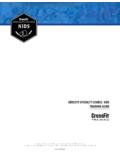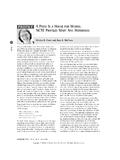Transcription of FIRE RISK PREVENTION AND CONTROL …
1 International Journal of Science, Engineering and Technology Research (IJSETR), Volume 3, Issue 4, April 2014 1084 ISSN: 2278 7798 all rights reserved 2014 IJSETR Abstract fire is the major hazard in the industries which perhaps result in disaster. Ignition of fire can be of many reasons in industries. Friction from brake, coal spillage, excessive temperature of the drive seizing of gears, sparks, etc. are some of the reasons for the outbreak of fire that leads to tragic end of the industry. Providing auto sprinklers would definitely reduce the risk of fire by automatically activating with the smoke detector. The only constrain is the live power lines which may turn dangerous to the personnel present as it would give adverse shock.
2 To solve this problem the electrical power should be totally cut off first when the temperature rise is sensed about 900C and then the sprinklers shall work to CONTROL the fire . This paper present experimental setup for PREVENTION of fire and also suggest fire risk PREVENTION and CONTROL measures in belt conveyor. Index Terms heat sensor, fire sensor, water pump. I. INTRODUCTION Conveyors Now a day s belt conveyors system is not only used in cement industries but also applied in mining industries, power plant industries, food industries and production industries, etc. each year there many injuries and fatal, that occur around belt conveyor. Conveyors are power equipment s commonly used for to transferring the bulk or unit load continuously or intermittently; unidirectional from one location to another location over fixed path, where the main function is to transmit the material by the help of movement of some parts/machinery of the equipment.
3 Whole setup does not move. Conveying equipment is a group of machines which move loads in a continuous flow and sometimes may not lifting gear. Conveyors are efficient way of moving materials. Conveyors are most important mechanical material handling equipment s. Study area The India cements limited located in the sankari, Tamilnadu. This is the largest producer of cement in south India. The capacity of the plants is over 2000 tones per day. Types of conveyor The following types of the conveyor are used in the India cements limited: BELT CONVEYOR BUCKET ELEVATOR CHAIN CONVEYOR SCREW CONVEYOR Belt conveyor A belt conveyor consists of an endless flat and flexible belt of sufficient strength, made of fabric, rubber, plastic, leather or metal, which is laid over two metallic flat pulleys at two ends and driven in one direction by driving one of the two end pulleys.
4 Material is placed on this moving belt is for transportation. The active half of the belt is supported by idler rollers or slider bed. The return half of the belt may or may not be supported, as it generally does not carry any additional load other than its own weight. Belt conveyor are used in following areas Crusher Coal storage Stacker & reclaimer Raw mill Coal mill Cement mill Packing & dispatch II. fire A local fire caused by the transported coal or equipment failures is a high risk because it might lead rapidly to a big accident and damage, so early fire detection is essential for to prevent the accident. The fire to create the electrical collapse. Due to the extension of such facilities, fire RISK PREVENTION AND CONTROL MEASURES IN BELT CONVEYOR H.
5 Manojkumar, International Journal of Science, Engineering and Technology Research (IJSETR), Volume 3, Issue 4, April 2014 1085 ISSN: 2278 7798 all rights reserved 2014 IJSETR head sensor and fire sensor installed in the nearness. Can detect such fire in an early stage and localize it. fire hazards Conveyor enclosures and supporting structures are normally of non-combustible construction. However, any large fire in the enclosure may damage, or in the case of included conveyors cause the collapse of, structural elements. The principal fire load includes the material being conveyed and the belt itself. Both combustible and non-combustible materials are transported in bulk on conveyors.
6 Combustibles include scrap, empty bag, and coal. Non-combustible products include lime stone, gypsum and flyash. If the product is packaged, the fire load increases. Burning product may also be passed from one belt to the next, thereby spreading the fire . Conveyor belts are made of plies of rubber and fabric of natural or man-made fibres. Conventional belts are easily ignited, spread fire rapidly and liberate large quantities of smoke. Inclined conveyors may cause a flue effect thereby increasing the spread of the fire . An unusual occurrence is if the belt should part under tension: the burning ends will fly apart causing two remote fires. The fire hazard increases with the age of the belt; older belts may become coated or impregnated with oils or combustible residue.
7 III. CAUSES OF fire Ignition sources The investigations into possible ignition sources for conveyor belt fires showed various reasons for the occurrence of fires. The following non-exhaustive list summarizes causes for conveyor belt fires without any classification: Friction of belts Collapsed idler bearing Fires of flammable liquids Slide of a belt in a drive Jammed rollers Friction from brake Coal spillage Excessive temperature of the drive Seizing of bearings Seizing of gears Collapsed pulley bearing Sparks, electrical causes Hot surfaces Other ignition sources Apart from the ignition sources mentioned above, which are related to the conveyor belt installation itself, other flammable materials are present in the surrounding area of conveyor belt.
8 Such materials, while considered basically inert in terms of acting as fire sources, may under certain conditions alone or in combination with other materials, act as sources of ignition for a conveyor belt fire . IV. EXPERIMENTAL SETUP The overall experimental setup consists of different equipment s and measuring sensor devices such as Relay, Preset temperature, LED, Connector, IC, Water pump, Heat and fire sensor and Conveyor. A basic layout of the experimental setup is shown in the figure EXPERIMENTAL SETUP 1 Input Supply 2 IC 3 Pump Relay 4 Power Relay 5 Connector-1 6 Connector-2 7 Water Pump 8 Conveyor 9 fire Sensor 10 Heat Sensor 11 Water Outlet 12 Main Power Supply Two relays such as pump relay and power relay are used.
9 One is used to cut off the power supply and then other one used for activating the water pump. Two LED are used. White LED indicates the normal DC power supply signal and green LED indicates the pump activating signals. Heat and fire sensor are connected near the conveyor belt. Sprinkler is attached to the top of the conveyor belt which comes from water pump. The heat sensing temperature is set by the preset temperature. Transistor, IC, connector and resistance are connected in the circuit board. 9 11 11 10 12 8 1 3 7 5 2 6 4 International Journal of Science, Engineering and Technology Research (IJSETR), Volume 3, Issue 4, April 2014 1086 ISSN: 2278 7798 all rights reserved 2014 IJSETR Experimental components The following experimental setup components are given below Relay Water pump Preset Transistor Connector Resistance Diode Integrated circuit Heat sensor PTC thermistor sensor Light emitting diode Methodology An experimental setup has been done to test the process.
10 The heat and fire sensor continuously monitors the temperature present in the conveyor region and gives signal to the preset resistor where a particular temperature has been presented. Once the preset temperature has been reached the preset resistor gives signal to the relay where relay cuts off the electrical line which LED in the setup activates another relay which gives supply to the water pump and it is activated and water gets sprayed. Once the temperature reaches below the preset temperature again the signal is given to relay through preset resistor and the relay cuts off the water pump and activates the electrical line which is LED in this setup. The figure Depicts the fire or normal working condition, figure and indicates the cut-off power supply and water flow in the conveyor respectively, and figure to indicates the reduction of the fire in conveyor.














